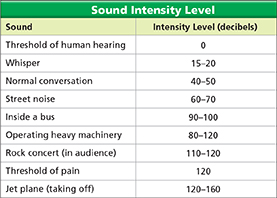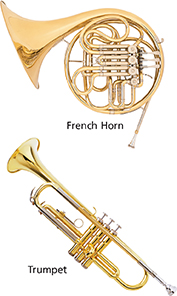Intensity and Loudness Intensity
is the rate at which a wave's energy flows through a given area. Sound intensity depends on both the wave's amplitude and the distance from the sound source. If someone whispers in your ear, the sound intensity may be greater than when someone shouts at you from the other end of a field.
Sound intensity levels are measured in units called decibels. The decibel (dB) is a unit that compares the intensity of different sounds. The decibel scale is based on powers of ten. For every 10-decibel increase, the sound intensity increases tenfold. Figure 15 shows the intensity levels of some common sounds. A 0-decibel sound can just barely be heard. A 20-decibel sound has 100 times more energy per second than a 0-decibel sound. A 30-decibel sound delivers 1000 times more energy per second than a 0-decibel sound.
Figure 15 Lengthy exposure to sounds more intense than 90 decibels can cause hearing damage. Analyzing Data Which sounds are potentially dangerous?
 d
dUnlike intensity, loudness is subjective—it is subject to a person's interpretation. Loudness is a physical response to the intensity of sound, modified by physical factors. The loudness you hear depends, of course, on sound intensity. As intensity increases, loudness increases. But loudness also depends on factors such as the health of your ears and how your brain interprets the information in sound waves.
Frequency and Pitch
Try plucking a stretched rubber band. Then, stretch the rubber band farther and pluck again. You should be able to see the vibration become faster as you hear the sound frequency become higher. The frequency of a sound wave depends on how fast the source of the sound is vibrating.
The size of a musical instrument tells you something about the frequencies it can produce. The trumpet in Figure 16 can produce higher frequencies than the French horn. Both instruments produce different frequencies by changing the length of tubing through which air moves. The air in the tubing forms a standing wave. The longer the tubing, the longer is the wavelength of the standing wave, and the lower is the frequency of the note produced.
Figure 16 The French horn can produce lower notes than the trumpet because it can make a longer tube for a standing wave.

Pitch is the frequency of a sound as you perceive it. Pitch does depend upon a wave's frequency. High-frequency sounds have a high pitch, and low-frequency sounds have a low pitch. But pitch, like loudness, also depends on other factors such as your age and the health of your ears.





 What is loudness?
What is loudness?